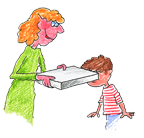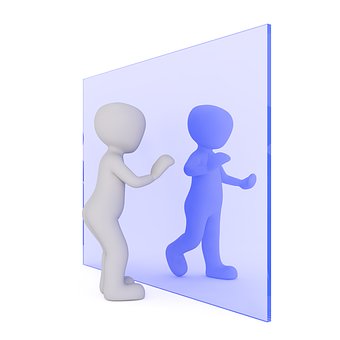Activities, with a few suggestions, to add to your resources for teaching light. I presented this information at a workshop at the OSTAstate conference.
 |
The Evidence Statement for NGSS 1-PS4-2 suggests observations in a dark room, a pinhole box, or a video of a cave explorer. Objects in darkness can be seen only when illuminated.
I don’t have those resources available so I cut a small hole in one end of a box and asked a child to look through the hole and tell me what is seen in the box. He can’t see anything because there’s so little light in the box the geometric shapes I glued on the opposite side of the box aren’t visible. When I open the lid the student is able to see the shapes I drew on the inside of the box. |
Notice how I’m holding the box by the end. I’m covering up a hole I cut at that end. This lets me use the box twice. Look in one end to try to see three circles, reverse the box to look in the other end to try to see four triangles. By covering the hole, there’s very little light in the box and students will only see the shapes when the box is opened.
 |
Some people think that there are animals who can see in the dark. Can they?
Check out this TED-Ed video by Anna Stöckl to watch an explanation. If you have primary students, consider watching on your own and then showing the video without sound. It’s closed captioned so that can help you with a narrative! You might notice the format of the video is different. I pasted the youtube URL to PureView, a way to delete all the ads, video suggestions, and comments that clutter a youtube site. |
To see an object light must reflect from the object to your eye. A fun way to show this is with a darkened room, a laser pointer, and a spray bottle. I turn on the laser and hold it behind my hand so they can’t easily see where I’m pointing. They have to use mist from their spray bottle of water to find my laser light. Without the water, they don’t see the light travel across the room, they only see it reflect from the wall.
  |
How does light travel through different materials? That’s the focus included in the Evidence Statement for NGSS 1-PS4-3.
An obvious suggestion is showing students different materials and discussing what is observed when the materials are held in front of a light source. You could have students complete a scavenger hunt. Both these activities are included in a great web site with engineering suggestions, TeachEngineering.
|
 |
How about introducing shadows and shadow puppets? There are many online videos to consider, I like this one by Corina Bona.
Darken the room, set up a bright light, and let kids try their hands at making shadows! Remember to read the poems “Shadow Race” and “Shadow Wash” by Shel Silverstein. |
Just for fun, to get kids talking about light and to learn about their thinking on this topic, you might show them water beads, water cubes, or a pyrex test tube in vegetable oil. The last option is amazing but very messy so I found a video you might show instead.
 |
Pour water into a bowl full of water beads and the beads seem to disappear. What’s happened to the beads?
That’s the video you’ll see that goes with the activity described at SteveSpangler Science. The beads (some call them Warblettes or Orbeez) are made almost entirely of water and light travels through the water beads just like water so they’re very difficult to see – sometimes just their ghostly edges. Hold one up carefully and look through it to see everything upside down because the bead is a lens. Check out this video from 3:20-4:50, to see astronaut Don Pettit look at you through a giant sphere of water on the International Space Station. He has a wonderful series of videos your students will enjoy. |
Steve also sells water cubes. Place a cube in water and check it every hour or so to see how it changes shape and grows up to 200x larger while absorbing water over 24 hours. Compare the size of the original cube to the hydrated cube. What happens if you leave the cube out of water?
For my workshop participants: We made a bottle with a floating frog and one with a floating fish. Here’s a video about hydrating the crystals. Here’s a video of the activity about creating the jar using a bug. If the videos don’t open, I download them and then they play from my computer.
 |
Steve Spangler demonstrates how to hide broken glass in a large bowl of vegetable oil. This is a FABULOUS demonstration but quite messy both to set up (broken glass) and clean up (broken glass in vegetable oil).
Light travels through this type of glass in the same way as the oil so the glass seems to be invisible. Sometimes it is better to show and discuss a video instead of setting up a demonstration that requires safety glasses, gloves, and a messy set up and clean up. |

